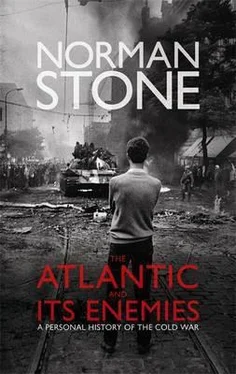Saigon, the Southern capital, was then a backwater of French colonial architecture, with its Hôtel Caravelle on the rue Catinat, where Graham Greene talked Pascal to despairing French officers in the stink of rotting vegetation in the marsh heat. It was not at all well organized, and there were battles of some depth between Buddhists and Catholics, while protection rackets pretended to be religions, and the drugs trade flourished. The picture was further confused because there were still French influences, and the refugees from the North made everything difficult. Some wished to take land, and that opened up a dimension of the Vietnam imbroglio which made it, for some academics, romantic: like Cuba, Vietnam was supposed to be having a ‘peasant war’. This was a situation well understood by Ho, perhaps via Mao, but certainly through his Comintern background. It was not so much a matter of class confict between poor peasant and rich peasant, but between poor peasants and their creditors; besides, within and between villages there were generally deeply felt and sometimes hereditary grievances that could be exploited by Communist guerrillas who knew the ground. By the later fifties, guerrillas from the North were infiltrating the South, carrying out attacks on landowners and government servants. As ever, the Communists presented at least an organization, whereas the Saigon regime, preoccupied with internal fighting, was helpless; it appealed to the Americans.
Kennedy’s advisers, in 1960, were unanimously in favour of giving help and in 1961 7,000 Americans appeared, giving instruction in ‘statebuilding’, i.e. teaching the Vietnamese to be democratic in the American manner. Beefy, gold-braided Americans now had to deal with the South Vietnamese ruler, Ngo Dinh Diem, and found him very difficult: an austere, chaste figure, given to lecturing them about a fashionable French Catholic substitute ideology, ‘personalism’. He had taken over the insufferable loftiness of the French higher administrative style, and he had worked out that the way to avoid awkward questions was to talk and talk. He talked and talked, and the power at court was his sister-in-law, who banned divorce. Still, the Americans had had to deal with tiresome Asiatics in the past; these were not to get in the way. Strangely enough, it was only Johnson who had his doubts: ‘I don’t think it’s worth fighting for and I don’t think we can get out.’ De Gaulle (‘a rotten country’) also advised him against going in, but the academic advisers were all adamant.
This had been successfully — very successfully — done elsewhere in Asia, most obviously in the case of a Japan that was now lifted off on an extraordinary trajectory that would make her a world economic power, but also with South Korea and Taiwan. Colonization was not part of the programme: on the contrary, the American ambassador was expected to be avuncular and helpful, not domineering, and as a sign of this the embassy itself was not much protected — easy access and no bombproof windows. ‘Hearts and minds’ programmes taught English and showed Hollywood movies; a famous photograph showed a very slender Vietnamese boy wielding a baseball bat almost his own size at the behest of a protein-stuffed and well-intentioned soldier. Dollars flowed into Vietnam; so did advisers with the latest wisdoms of political science (in 1966 they staged a constitutional convention, as the country fell to pieces around them: some of the people present had even designed three constitutions and Samuel Huntington immortally remarked upon the ‘consensus-making bodies… viable institutions for power-sharing which would gradually lead to the legitimation of the entire governmental framework’). In all of this, security of body and soul naturally came first, and the Vietcong would have to be contained and defeated, the Americans helping where necessary. But some means to gain the peasants’ loyalty was also of elementary importance.
At the time, influential writers were saying that the central problem of ‘Third World’ countries was the great imbalance in land ownership — huge estates, downtrodden peasants. The peasants, dirt-poor, could not buy anything, so native industry did not develop; the rich just imported goods via some comprador class. Such was Sicily in the nineteenth century, such was Latin America in the twentieth (Barrington Moore is an outstanding writer on these subjects). The answer was for governments to intervene and give land to the peasant. Japan and Taiwan had had land reforms, for political reasons, and these were thought to have been successful, in that societies with an element of equality had emerged. There was much more to this story than met the eye. The most successful agriculture was practised (outside the great empty plains of America) in England, which even in 1930 had more land under the cultivation of great estates than Tsarist Russia in 1916. But in the decolonizing era, landowners were an obvious target for expropriation, and the contented, picturesque peasant made for good propaganda. In South Vietnam the growers of rice for export had thrived in the French period, and they were influential in Saigon. That they were Catholics, and the peasants generally not, mattered; the prevalence of the Chinese minority in the whole trade also mattered; and sometimes there was not even a language in common between lord and peasant.
Diem knew the complications, but his Army of the Republic of Vietnam (ARVN) was ragtag and his writ hardly went beyond Saigon. Efforts at land reform went slowly and badly, and the Vietcong, launching guerrilla attacks, made matters far more difficult. Peasants were herded into agrovilles and had to walk for hours to reach their plots; there was much bribery in the sale of, for instance, rat poison, and it was sometimes difficult for peasants to stop squatters from occupying their land. Surrounded by barbed wire, but badly defended, the peasants became demoralized, and the Vietcong knew how to exploit the situation. One of their first acts was to murder people who had the peasants’ confidence, such that, leaderless, they would be an open target. The reform programme, never enthusiastically pursued, was largely abandoned, and in Long An province only 1,000 tenants out of 35,000 received any land at all; many were expected to buy it whereas the Vietcong ‘gave’ it. Diem, surrounded by relatives — half of his cabinet — hardly knew what to do, beyond keeping the old system going, however bad, on the grounds that anything else would have been worse. The rural scene would no doubt have got better, as peasants moved to towns, reduced overpopulation and sent money home, as happened in happier climes. That was not to be. As the journalist Neil Sheehan says, ‘the Americans… were not gaining the communities of controlled peasants they sought. They were instead fostering temporary encampments of peasants motivated as never before to support the Vietcong.’
How were Americans to deal with assassins, clutching an old rifle, waiting for hours in ambush, their feet rotting in the rice paddy slush? Guerrillas who moved with great cunning to terrorize peasants in their huts? There were very good American officers, and one such was Lieutenant-Colonel John Vann, who had made his mark in Korea, and went to Vietnam as adviser — a man of enormous energy, a good organizer and brave without being foolhardy. He knew only too well what was going wrong in Vietnam. He had to deal with a Colonel Huynh Van Cao in the Plain of Reeds, the north-western corner of the Mekong Delta. It was close to the Cambodian border, where the Vietcong had sanctuary, and was a vile place to fight — swamp, waist-high reeds, clumps of bush and woods, stretching over two provinces. There were concrete blockhouses at the bridges, with rusting barbed wire, among fields of sprouting sugarcane, with canals, ditches and, in the season, a steady downpour. It was easy enough for the Vietcong to hide, where necessary in the water, breathing through a hollow reed; and they could come and go, noiselessly, on flat-bottomed boats. They would wait patiently, suddenly emerging to fire. The Saigon government had in effect lost the southern delta, and the northern delta, with its 2 million people, supplied much of the country’s food.
Читать дальше












![Edward Ellis - Adrift on the Pacific - A Boys [sic] Story of the Sea and its Perils](/books/753342/edward-ellis-adrift-on-the-pacific-a-boys-sic-s-thumb.webp)